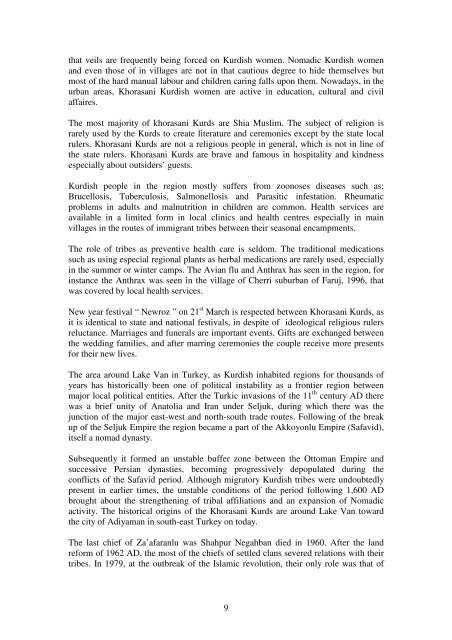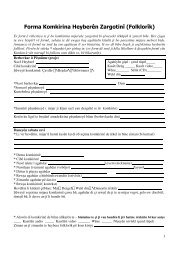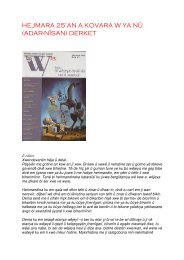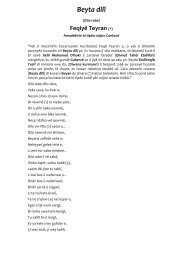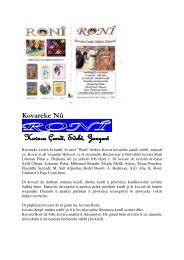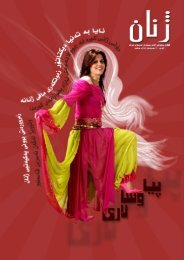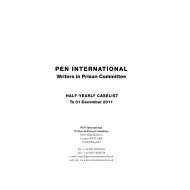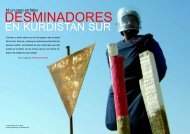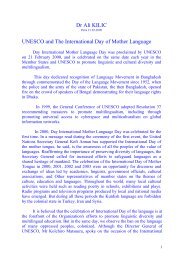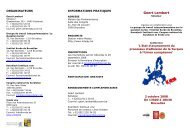The Kurds in Khorasan, North-east of Iran - Pen-Kurd
The Kurds in Khorasan, North-east of Iran - Pen-Kurd
The Kurds in Khorasan, North-east of Iran - Pen-Kurd
Create successful ePaper yourself
Turn your PDF publications into a flip-book with our unique Google optimized e-Paper software.
that veils are frequently be<strong>in</strong>g forced on <strong>Kurd</strong>ish women. Nomadic <strong>Kurd</strong>ish womenand even those <strong>of</strong> <strong>in</strong> villages are not <strong>in</strong> that cautious degree to hide themselves butmost <strong>of</strong> the hard manual labour and children car<strong>in</strong>g falls upon them. Nowadays, <strong>in</strong> theurban areas, <strong>Khorasan</strong>i <strong>Kurd</strong>ish women are active <strong>in</strong> education, cultural and civilaffaires.<strong>The</strong> most majority <strong>of</strong> khorasani <strong><strong>Kurd</strong>s</strong> are Shia Muslim. <strong>The</strong> subject <strong>of</strong> religion israrely used by the <strong><strong>Kurd</strong>s</strong> to create literature and ceremonies except by the state localrulers. <strong>Khorasan</strong>i <strong><strong>Kurd</strong>s</strong> are not a religious people <strong>in</strong> general, which is not <strong>in</strong> l<strong>in</strong>e <strong>of</strong>the state rulers. <strong>Khorasan</strong>i <strong><strong>Kurd</strong>s</strong> are brave and famous <strong>in</strong> hospitality and k<strong>in</strong>dnessespecially about outsiders’ guests.<strong>Kurd</strong>ish people <strong>in</strong> the region mostly suffers from zoonoses diseases such as;Brucellosis, Tuberculosis, Salmonellosis and Parasitic <strong>in</strong>festation. Rheumaticproblems <strong>in</strong> adults and malnutrition <strong>in</strong> children are common. Health services areavailable <strong>in</strong> a limited form <strong>in</strong> local cl<strong>in</strong>ics and health centres especially <strong>in</strong> ma<strong>in</strong>villages <strong>in</strong> the routes <strong>of</strong> immigrant tribes between their seasonal encampments.<strong>The</strong> role <strong>of</strong> tribes as preventive health care is seldom. <strong>The</strong> traditional medicationssuch as us<strong>in</strong>g especial regional plants as herbal medications are rarely used, especially<strong>in</strong> the summer or w<strong>in</strong>ter camps. <strong>The</strong> Avian flu and Anthrax has seen <strong>in</strong> the region, for<strong>in</strong>stance the Anthrax was seen <strong>in</strong> the village <strong>of</strong> Cherri suburban <strong>of</strong> Faruj, 1996, thatwas covered by local health services.New year festival “ Newroz ” on 21 st March is respected between <strong>Khorasan</strong>i <strong><strong>Kurd</strong>s</strong>, asit is identical to state and national festivals, <strong>in</strong> despite <strong>of</strong> ideological religious rulersreluctance. Marriages and funerals are important events. Gifts are exchanged betweenthe wedd<strong>in</strong>g families, and after marr<strong>in</strong>g ceremonies the couple receive more presentsfor their new lives.<strong>The</strong> area around Lake Van <strong>in</strong> Turkey, as <strong>Kurd</strong>ish <strong>in</strong>habited regions for thousands <strong>of</strong>years has historically been one <strong>of</strong> political <strong>in</strong>stability as a frontier region betweenmajor local political entities. After the Turkic <strong>in</strong>vasions <strong>of</strong> the 11 th century AD therewas a brief unity <strong>of</strong> Anatolia and <strong>Iran</strong> under Seljuk, dur<strong>in</strong>g which there was thejunction <strong>of</strong> the major <strong>east</strong>-west and north-south trade routes. Follow<strong>in</strong>g <strong>of</strong> the breakup <strong>of</strong> the Seljuk Empire the region became a part <strong>of</strong> the Akkoyonlu Empire (Safavid),itself a nomad dynasty.Subsequently it formed an unstable buffer zone between the Ottoman Empire andsuccessive Persian dynasties, becom<strong>in</strong>g progressively depopulated dur<strong>in</strong>g theconflicts <strong>of</strong> the Safavid period. Although migratory <strong>Kurd</strong>ish tribes were undoubtedlypresent <strong>in</strong> earlier times, the unstable conditions <strong>of</strong> the period follow<strong>in</strong>g 1,600 ADbrought about the strengthen<strong>in</strong>g <strong>of</strong> tribal affiliations and an expansion <strong>of</strong> Nomadicactivity. <strong>The</strong> historical orig<strong>in</strong>s <strong>of</strong> the <strong>Khorasan</strong>i <strong><strong>Kurd</strong>s</strong> are around Lake Van towardthe city <strong>of</strong> Adiyaman <strong>in</strong> south-<strong>east</strong> Turkey on today.<strong>The</strong> last chief <strong>of</strong> Za’afaranlu was Shahpur Negahban died <strong>in</strong> 1960. After the landreform <strong>of</strong> 1962 AD, the most <strong>of</strong> the chiefs <strong>of</strong> settled clans severed relations with theirtribes. In 1979, at the outbreak <strong>of</strong> the Islamic revolution, their only role was that <strong>of</strong>9


